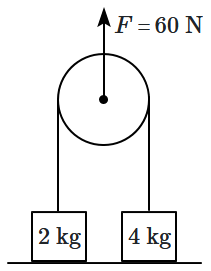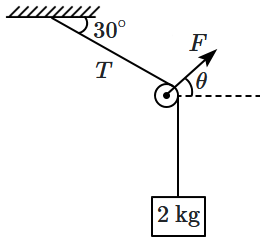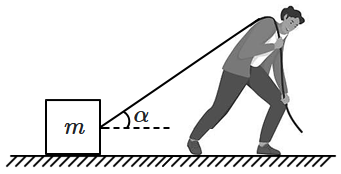| 1. |  |
2. |  |
| 3. |  |
4. |  |
लिफ्ट के ऊपर की ओर त्वरण के परिमाण और लिफ्ट को समर्थन देने और स्थानांतरित करने के लिए उपयोग किए जाने वाले केबल में तनाव के बीच संबंध को कौन सा ग्राफ सबसे अच्छा दर्शाता है?
| 1. |  |
2. |  |
| 3. |  |
4. |  |
| 1. | The force exerted on the block is actually larger than the force on the rope. |
| 2. | It has nothing to do with the rope and everything to do with the friction force. |
| 3. | The person pulling exerts a larger force on the rope. |
| 4. | The action-reaction forces act on different bodies. |
न्यूटन का तीसरा नियम का कथन है, "प्रत्येक क्रिया के लिए, एक समान और विपरीत प्रतिक्रिया होती है।" इसका मतलब यह है कि रस्सी एक द्रव्यमान पर उसी परिमाण के बल के साथ खींचेगी जिसे द्रव्यमान रस्सी पर वापस खींचता है! जब तनाव एक संलग्न रस्सी पर आरोपित होता है तो द्रव्यमान विराम से स्थानांतरित करने में सक्षम क्यों होता है ?
| 1. | ब्लॉक पर लगाया गया बल वास्तव में रस्सी पर लगाए गए बल से बड़ा होता है। |
| 2. | इसका रस्सी और घर्षण बल से कोई लेना - देना नहीं है। |
| 3. | खींचने वाला व्यक्ति रस्सी पर एक बड़ा बल लगाता है। |
| 4. | क्रिया - प्रतिक्रिया बल विभिन्न पिण्डो पर कार्य करते हैं। |

1. \(5~\text{m/s}^2\)
2. \(10~\text{m/s}^2\)
3. \(2.5~\text{m/s}^2\)
4. \(1.5~\text{m/s}^2\)
\(60~\text N\) का एक बल प्रणाली पर लंबवत रूप से आरोपित होता है, जहां घिरनी और डोरी आदर्श होते हैं। ब्लॉक ज़मीन पर हैं। चरखी का ऊपर की ओर त्वरण है: (\(g=10\) m/s2 लें)

1. \(5~\text{m/s}^2\)
2. \(10~\text{m/s}^2\)
3. \(2.5~\text{m/s}^2\)
4. \(1.5~\text{m/s}^2\)
| 1. | \(\dfrac{2}{3}\) | 2. | \(\dfrac{3}{2}\) |
| 3. | \(\dfrac{1}{2}\) | 4. | \(\dfrac{1}{3}\) |
2 किलोग्राम का बॉक्स एक क्षैतिज फर्श पर विरामावस्था में है। बॉक्स पर \(30~\text{N}\) का एक क्षैतिज बल लगाया जाता है, लेकिन यह चलता नहीं है। स्थैतिक घर्षण का गुणांक है: (\(g=10~\text{m/s}^2\) लें)
| 1. | \(\dfrac{2}{3}\) | 2. | \(\dfrac{3}{2}\) |
| 3. | \(\dfrac{1}{2}\) | 4. | \(\dfrac{1}{3}\) |

The tension \((T)\) in upper part of the string is:
1. \(20~\text N\)
2. \(10~\text N\)
3. \(40~\text N\)
4. \(20\sqrt3~\text N\)
डोरी के ऊपरी भाग में तनाव \((T)\) है:
1. \(20~\text N\)
2. \(10~\text N\)
3. \(40~\text N\)
4. \(20\sqrt3~\text N\)

The angle \(\theta\) equals:
1. \(30^\circ\)
2. \(60^\circ\)
3. \(90^\circ\)
4. \(45^\circ\)
कोण \(\theta\) बराबर होगा है:
1. \(30^\circ\)
2. \(60^\circ\)
3. \(90^\circ\)
4. \(45^\circ\)

The force \(F\) equals:
| 1. | \(20~\text N\) | 2. | \(10~\text N\) |
| 3. | \(20\sqrt3~\text N\) | 4. | \(10\sqrt3~\text N\) |
\(F\) का परिमाण होगा
| 1. | \(20~\text N\) | 2. | \(10~\text N\) |
| 3. | \(20\sqrt3~\text N\) | 4. | \(10\sqrt3~\text N\) |
| 1. | \(\dfrac{g}{4}\) | 2. | \(\dfrac{g}{2}\) |
| 3. | \(\dfrac{3g}{4}\) | 4. | \(3g\) |
एक बक्सा जिसका द्रव्यमान \(M\) है, एक लिफ्ट की सतह पर रखा हुआ है जो नीचे की ओर गिर रही है। लिफ्ट स्थिर त्वरण a के साथ नीचे की ओर त्वरित हो रही है। a का ऐसा कौन सा मान होना चाहिए ताकि बक्सा सतह पर \(\dfrac{Mg}{4}\) बल आरोपित करे ?
| 1. | \(\dfrac{g}{4}\) | 2. | \(\dfrac{g}{2}\) |
| 3. | \(\dfrac{3g}{4}\) | 4. | \(3g\) |
An electric train is traveling along a straight, horizontal track. A constant resultant force (greater than zero) acts on the train in the direction of its motion. What happens to the magnitude of the train's acceleration and velocity while this force is acting?
| 1. | The acceleration increases, and the velocity remains constant. |
| 2. | The acceleration remains constant, and the velocity increases. |
| 3. | The acceleration decreases, and the velocity increases. |
| 4. | The acceleration remains constant, and the velocity remains constant. |
एक विद्युत ट्रेन सीधी, क्षैतिज पटरी पर चल रही है। ट्रेन की गति की दिशा में एक स्थिर बल कार्य कर रहा है। जब यह बल कार्य कर रहा है,
तो ट्रेन के त्वरण और वेग का परिमाण क्या होगा ?
| 1. | त्वरण में वृद्धि होती है, और वेग स्थिर रहता है। |
| 2. | त्वरण स्थिर रहता है, और वेग बढ़ता है। |
| 3. | त्वरण घटता है, और वेग बढ़ता है। |
| 4. | त्वरण स्थिर रहता है, और वेग स्थिर रहता है। |
Sam pulls a block of ice (mass \(m\)) across a level floor using a rope under a constant tension \(T.\) The rope is inclined at an angle \(\alpha\) to the horizontal. The block moves at a velocity \(v\) for a time \(\Delta t.\) The coefficient of kinetic friction between the ice and the floor is \(\mu_k.\)

What is the magnitude of the frictional force \(f\text{?}\)
1. \(0\)
2. \(\mu_kmg\)
3. \(T\cos\alpha\)
4. \(T\sin\alpha\)
सैम एक रस्सी की मदद से एक बर्फ के टुकड़े (द्रव्यमान m) को चिकनी, समतल सतह पर खींचता है, जिसमें रस्सी पर एक स्थिर तनाव T होता है। रस्सी क्षैतिज से एक कोण α पर झुकी हुई है। बर्फ का टुकड़ा एक वेग v से कुछ समय \(\Delta t\) के लिए चलता है। बर्फ और सतह के बीच गतिज घर्षण गुणांक\(\mu _k\) है।
घर्षण बल \(f\) का परिमाण क्या है?

1. \(0\)
2. \(\mu_kmg\)
3. \(T\cos\alpha\)
4. \(T\sin\alpha\)






